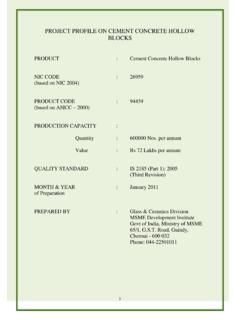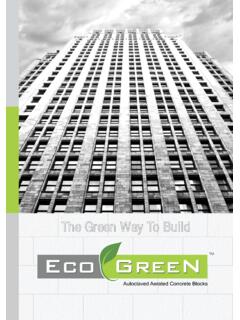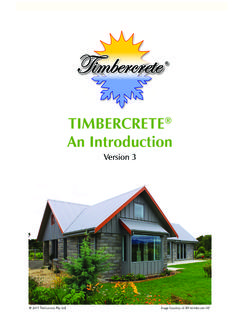Transcription of The Pros and Cons of Different Construction Systems
1 Page 1 of 11 The Pros and cons of Different Construction Systems By Clive Fewins Note This article appeared in a recent issue of Home Building & Renovating - a magazine targeted at the UK market (see: ) Although it provides much useful information on the pros and cons of Different Construction Systems , readers must remember that: The climatic and seismic conditions in Cyprus are completely Different to those of the UK. Not all of these Construction Systems are available in Cyprus. All property built in Cyprus needs to comply with strict government anti-seismic regulations.
2 The article is reproduced in its entirety. How will you build your house? Brick and block, timber frame, or one of the alternatives? Clive Fewins looks at the pros, cons and relative costs of each system . Many people are surprised to learn that the brick, stone, render or timber that make up the outer walls of a modern house play little or no structural role. Although they help keep the building warm and dry, they are otherwise only decorative. The task of supporting the floors and roof is usually played by an inner structure - usually concrete blockwork.
3 With the exception of oak frame, the choice of this Construction system , therefore, can be considered largely independently of the architectural style of the building. Traditional masonry cavity walls, most commonly brick with an inner structural leaf of concrete block, have dominated housebuilding in the UK for the past eighty years, but there are a number of other Systems that are gradually making inroads, including timber frame, steel frame and now new Systems such as Structural Insulated Panels and Permanent Insulated Formwork.
4 One question that perpetually raises its head is which is cheapest of the two most prevalent Systems - timber frame or brick and block? The answer: it depends. However, before you get involved with trying to answer this question it is worth considering all of the other forms of Construction . In many areas of the UK, Systems that originated on the other side of the Atlantic, like SIPs Structural Insulated Panels are making great inroads. Many architects look very favourably on this system , in which a series of lightweight panels comprising sheets of plywood laminated to a core of expanded polystyrene insulation board, are bonded Page 2 of 11 together by a simple slotting-in system to form the walls and quite often the roof too.
5 A few years ago Permanently Insulated Formwork (PIF Systems ) fell into this new category, but today it is a method of solid wall Construction that is well established, while steel frame, a system last used extensively in the 1940s and early 1950s, is being tipped by industry insiders as hot favourite for the housebuilding system of the future. If professionals appear reluctant to be dogmatic on which Systems are more economic, it is probably because there is no definitive answer. If you are building a house in Scotland, there are so many timber frame companies that it might well be cheaper than masonry, while there are certain to be areas of the UK where domestic Construction companies have a strong market and have got cavity walling Systems down to a fine art.
6 Cost is unlikely to be the main consideration, anyhow, as the Construction system is only likely to represent 15 per cent at the most of the overall Construction costs. If you want to build fast, then timber frame or SIPs are probably the route for you. If you want a flat roofed house shaped like a guitar, then cast concrete or PIFs may well be best. If you are not a building professional and want to build the outside walls of your new self-build yourself, then it is not hard to find someone who can tell you the essence of building in brick and block.
7 Though progress may be slow, you are unlikely to fail if you seek good advice. There are many factors to take into consideration when it comes to specifying the best structure for your new house. On the following pages we look at the advantages, disadvantages and relative costs of each of the many Systems available, along with a comprehensive directory of the major suppliers in each field. Masonry The vast majority of houses built in the UK have walls of masonry - but that does not necessarily mean they have a cavity. Until the 1920s almost all houses were built with solid walls - frequently of what was known as nine inch brick.
8 However, cavity walls were also known to the Victorians, a practice they called hollow wall Construction . As early as 1805 it was pointed out that hollow walls , as they were known then, could be much warmer than solid walls because of the air trapped in the cavity between. A cavity wall comprises three elements: an inner and outer leaf of masonry and an air space between. The modern cavity wall, with wall ties between the skins, drip trays over window openings and insulation in the centre, only came into its own in the 1930s, when it was common to have a 225mm (9 ) inner skin.
9 The width of the cavity for many years was generally 50mm, but nowadays it is more likely to be 75mm in order to accommodate the thickness of cavity insulation required to achieve the u-value as stipulated by building regulations. Advantages of Masonry Walls The materials and skills required to build in masonry are widely available across the UK. It is therefore possible to start building work in masonry almost instantly. It should be Page 3 of 11 possible to build two skins of blockwork and render the outside for less than 40/m2. With a brick skin expect to pay up to 20/m2 more, depending on your choice of brick.
10 Masonry cavity walling is therefore almost certainly the cheapest structural system for your new self-build - although the difference will be marginal on a one-off house and so relative cost should be considered in the context of the other pros and cons of the alternatives. A masonry structure gives a house a feeling of solidity, as the density of the blocks provides a high level of acoustic mass, helping to deaden noise outside the building. Building internal partition walls from masonry, as opposed to timber stud walls covered with plasterboard, will further enhance the feeling of solidity and provide sound deadening between rooms.






